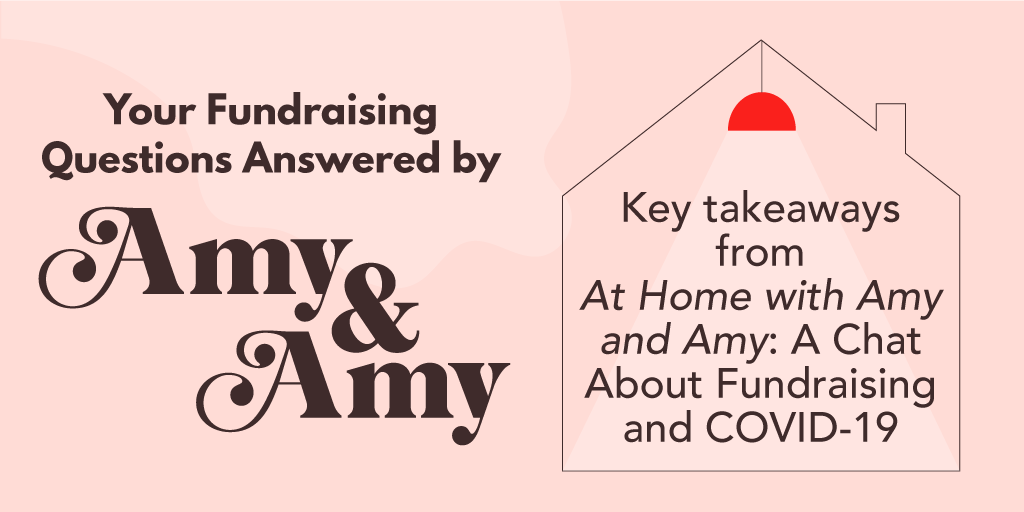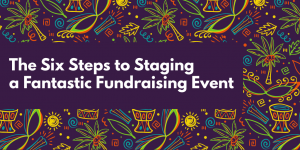We’re finally seeing some good signs that signal the country’s readiness to re-open and move past the coronavirus pandemic. Cases and deaths in the hardest hit areas are on the decline and many states have significantly loosened restrictions placed back in March.
On May 13, we held a live chat, At Home with Amy & Amy. Two fantastic fundraisers, Amy Boroff and Amy Eisenstein, answered some of your questions about what your nonprofit can do now to adjust and prepare for the new normal.
One of the central themes of the webinar was to keep communications going. Amy and Amy stressed the importance of keeping donors in the loop about your activities and continuing to ask for support.
Webinar attendees asked their own questions throughout the conversation. Here are some of the questions asked by your fellow fundraisers and answered by Amy and Amy:

What can organizations that rely on event-based fundraising do to diversify their revenue?
Many organizations are wishing they diversified their fundraising long ago. Nonprofits that rely on events to drive their fundraising are struggling right now. But Amy and Amy discussed a few ways to adjust if your organization had to cancel an event this spring.
Amy Eisenstein suggested going through your registered event attendees and finding the ones that attend your event year after year.
Ask yourself who is supporting your organization because they actually love your organization and its mission, not just because you’re having a fun charity night. Then give those people a call and let them know you’re as disappointed as they are you had to cancel. Share how your organization is continuing to achieve its mission and ask them to continue their support..
You can even ask them to repurpose their ticket or registration fee into a donation!
Many organizations have also had success moving to a digital event. And as Amy Boroff pointed out, don’t forget about your event sponsors if you do so! Let them know you’re going digital and ask if they would like to sponsor your digital event.
Your corporate sponsors support your organization because their values and beliefs align with your mission. COVID-19 hasn’t changed this, so it’s important to think of creative ways to get your sponsors involved and secure their support.

Some of our organization’s leaders are wondering, is it possible to overcommunicate right now?
Most organizations are facing the opposite problem. Too many organizations stepped off the gas because of the initial uncertainty around the coronavirus pandemic. Many nonprofits probably need to find ways to communicate more, not less.
Amy and Amy said they’ve only seen problems with over-communication from some large, national organizations who are sending an email every day. But as long as you have an important message to share, it’s fine to reach out two or three times a week to keep in touch.
Don’t forget, some members of your audience may not see an email message the first time you send it. You can resend messages to those who never opened or clicked on a prior email. It’s also important to communicate through different channels to reach more donors.
But you don’t have to send the same messages to everyone! Use your data to your advantage. You may have some messages intended for your entire donor base. But don’t forget to work in special communications for different audience segments like your major donors!

What are your thoughts on launching a planned giving program right now?
During the webinar, Amy Boroff said the key word in this question was “launching.” If you already have a planned giving program, you can post some details about it on your website. But launching a planned giving program now may seem distasteful.
You definitely don’t want to look like you’re trying to cash in if a donor becomes ill with COVID-19!
However, if you are looking for a way to diversify your fundraising, a monthly giving program might be more appropriate! Ask donors if they would like to support your mission by committing to a small monthly donation.
Finances are on everyone’s mind with unemployment rates at all-time highs and several industries on hold all together. So, you may not want to count on securing large year-end gifts this December. But a monthly giving program can ease the burden on a donor’s wallet while making your fundraising more consistent from month to month.

How would you craft messages for an organization that is not servicing people on the frontline?
If your mission was worth supporting before the coronavirus pandemic, it still matters now. We’ve stressed this point in several of our COVID-19 blog posts and it became a theme during our fundraising webinar.
As Amy Eisenstein made clear, “Your mission is not diminished because there are frontline organizations in need. However, you may need to get more creative and reframe your message.”
For example, think about how the work your organization puts in now affects your goals in the future. An independent school may focus their message on their mission of building up tomorrow’s leaders. Then, they can explain tangible ways that securing donations now helps your students grow into that role.
Your job will be easier if you’ve cultivated a donor base of people who identify with your work on a personal level. You won’t have to work as hard to connect the dots when donors already see themselves as an important part of your work.
Most importantly, don’t back down because you’re not a healthcare worker. Keep telling your story, providing examples of your mission in action, and ask for support!







